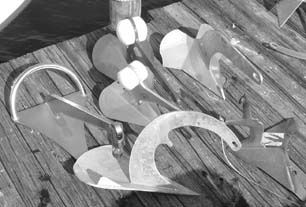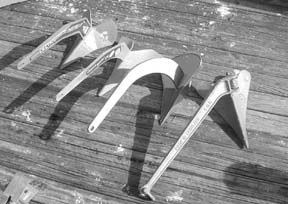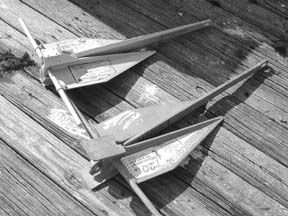The more we test anchors, the more we remind ourselves of the obvious: This is a topic fraught with variables. It’s like the blind men trying to describe the elephant, each having hold of a different pachydermal part. Yet the more circumstances in which we test, the better we get to know these metallic comrades upon which we place so much responsibility.

Here’s a recap of the tests over the last few years.
In the February 1, 1998 issue we reported the results of a test of nine anchors for initial setting ability (in wet, packed sand). The clear winner was the Bruce, followed, in the order of how they did, by the Super Max, Claw, Fortress FX-11, West Marine Performance2, Delta, Danforth 20-H, and CQR. It was noted that in tests by other groups, the Bruce was not as good at ultimate holding power. Our own subsequent holding power tests have tended to confirm that, as well as our initial observations: The Bruce, in many conditions, is a ferocious setting anchor.
The next test, also in sand, was for holding ability. The results were reported in the January 1, 1999 issue. Among the 15 anchors tried, two new ones, the Spade Model 80 and the Bulwagga, did best, holding to 1,000 lbs. and 880 lbs. respectively, as measured on a Dillon dynamometer. Then came the CQR, Delta, Fortress, West Marine Performance2, Super Max, Danforth Deepset II, Bruce, Vetus, Claw, etc.
Then there was a test of 17 anchors in mud, reported in the December 1999 issue. This time the Barnacle and CQR anchors triumphed, followed by the Bulwagga, Spade, Danforth Deepset II, Delta, Vetus, Bruce, etc.
In the January 15, 2001 issue we reported the abilities of 18 anchors to reset themselves (in muddy sand) when set initially at 200 lbs., then veered 140 degrees and pulled again. The best in this test—those that reset with little or no breakout or movement—were the Bruce, the Fortress, the Supermax (with adjustable shank), and the Spade Model 80.
The results of our last anchor test, in which we tried out the Kingston QuickSet and Digger anchors, were published in the January 15, 2002 issue. For that test we went against our usual procedure and used a powerboat with twin Suzuki 90-hp outboards to do the pulling. In 8-9 feet of water over a sandy mud bottom, we found that the QuickSet lived up to its name, then held very well in a straight line, popping out at 600 lbs., then resetting and holding to 780 lbs. before we backed off the throttles to keep from pulling cleats off the boat. We could not get the Digger to set after many attempts.
This brings us up to date.
Test Assumptions
Practical Sailor has been criticized for testing anchors of different weights against each other. Here’s how our reasoning was established, and how it has evolved.
In the fluky world of anchoring, there are simply too many variables ever to let testers achieve a perfectly even playing field. There are no absolutes, and certainly no single test can be taken as gospel on any anchor. That being the case, we decided years ago to approach this from a consumer-advocate point of view. We set up a scenario—a 30-32′ displacement boat anchored in sheltered water, with up to 40 knots of wind blowing, and asked anchor makers to submit the proper anchor for the job. The first batch or two of anchors we gathered ranged in weight from about 10 lbs. up to 35 lbs. All, supposedly, would do the job for our scenario.
Over the years we’ve discovered that weight can make the difference in some instances—but so can shape and design dynamics. Without a doubt, different bottom conditions favor different anchors, and even then, immediate circumstances can dictate a change of fortune at any time—a quahog clam, for instance, wedged between flukes and shank of a Danforth type, which we saw in the veer test a few years ago. If you overturned that anchor and pulled on it, you would think it was a lousy anchor.
We’ve seen the Spade Model 80, a large-sized but lightweight aluminum anchor, perform well consistently. It’s not the weight, but the shape, that makes that anchor do well, at least in the bottoms we’ve encountered. But there are bottoms—maybe packed sand covered with heavy grass?—in which the Spade might not get through very well, and the 35-lb. CQR will bully its way down.
We now have anchors in hand ranging up to 58 lbs. Some manufacturers have submitted them without being aware of those original sheltered-boat-in-strong-wind parameters, so we’ve let that scenario go.
We still run lighter and heavier anchors together in the same test—especially since light weight for equal performance is often one of a manufacturer’s main selling points. But we’re not so much testing anchors against each other as against themselves, always publishing the weight of the anchor and leaving it up to readers to extrapolate. This time we’ve put in our chart on pages 8-9 a column with an “Efficiency Ratio,” which we derived simply by dividing an anchor’s maximum pulling pressure by its weight.
We should be clear about two other things: First, in that chart heading we include the phrase “this test only,” because it would be unrealistic to expect the same ratings of the same anchors in other conditions.
Second, despite the fact that we’ve tried in the past to test anchors according to manufacturers’ recommendations, the real-life consensus around here is that it’s wise to buy a hook at least one size up from the size recommended. We don’t know a single experienced sailor who tries to “get by with a small-enough anchor.”
Test Procedures
In this year’s test, in Sarasota, Florida, 13 anchors were set initially by a powerboat with a 150-hp Mercury Optimax outboard. The same rode was used for all anchors—10 feet of 5/16″ proof-coil galvanized chain, shackled to 5/8″ Samson braid. Each was set at a 4:1 scope in the immediate vicinity of an anchored inflatable boat, which carried a 12-volt deep-cycle battery attached to a SurfaceDive diving rig. This rig (more about it in an upcoming Chandlery) allowed our diver to remain on the bottom for the better part of the work day, observing the initial sets and subsequent pulls.

The water depth throughout the testing averaged about 10 feet, with a low of about 9 feet at low water, which occurred about midway through our testing.
We didn’t use a dynamometer to measure pressure for the initial sets, because we didn’t feel that we could apply pressure evenly and equitably with the outboard. The idea was simply to get the anchors dug in, if possible at this less-than-ideal scope ratio.
The bottom consisted of approximately 15-18 inches of soft, fine-grained sand, atop a subsurface of hard-packed, larger-grained sand mixed with small broken shell. As it turned out, these conditions were very good for setting, and very poor for holding.
All 13 anchors set quickly in the soft sand at a 4:1 scope. Although we didn’t measure the pressures at that point, when we returned the next day to test rode sentinels (kellets) in exactly the same place (see page 38) we did use the dynamometer, and got consistent readings of 150-200 lbs. on the aluminum Vetus Danforth type we used for that test. We think that all of the 13 tested anchors initially set and held within that range.
The Veer and Pull
After the initial set, things got more difficult for our metallic contenders. After getting a good set in line with the flowing current, the powerboat crew cast off the rode, whose far end was managed by a crew ashore. This crew tailed the slack out of the rope rode, across the current, and then tied it into the shackle at one end of the Dillon dynamometer. The other end of the gauge was attached to a Powerwinch Model 915 12-volt trailer winch, with a single-line capacity of 5,900 lbs. The winch, in turn, was mounted on top of a stoutly braced wooden platform rising above the bed of a pickup truck.
Then the real tugging started. The rode was winched 90 degrees to its initial set, and then pulled (slowly, steadily, inexorably) toward the shore. The effective scope averaged between 7:1 and 8:1. Probably half the rode was unsupported by water, but we’re not accounting for that.
Our diver carefully watched what happened during the entire veer and pull of each hook, and surfaced to report his observations to the note-taker as anchors were being changed.
With minor exceptions, all 13 anchors stayed buried in the soft sand when they were veered. But as the winch applied pressure, only a few of the anchors could get a solid grip in the hard-packed sand and shell underneath. Most were simply dragged— shank, flukes, and chain, still buried—across the hard scrabble underneath. The diver could see it happening, and a hand ashore could feel the chattering through the taut rode.
It’s conjecture, but it seemed as if the layer of looser surface sand actually “buoyed up” the anchors as they were dragged, however slowly, preventing them from using their weight to get their sharp parts down into the hard-pack. However, there were several exceptions to this rule, and once again, we found that it’s not always the weight that makes the difference. In this case it seemed to have more to do with the sharpness and shape of the pointy parts.
Anchor Notes
With five new anchors to test, time constrained us from bringing out all of the anchors in our stable. So we settled on a representative cast of old standbys, in addition to the newcomers. Please refer to the chart on pages 8-9 for the specifics of what happened. Meanwhile, here are some observations.
The first new anchor is the prototype XYZ Anchor (17 lbs.). It looks more like a sculpture than an anchor, with a flattish plow, a sort of leg-with-foot projecting from the shank, and a short cable attached at the end of the shank. It’s the brainchild of Dragomir Ivicevic of DI Research and Design in New York. We became intrigued when he sent us a video of the anchor setting and resetting on a beach. No matter which way the rode was pulled, the anchor figured out a way to turn a sharp edge into the sand and keep on burying. So we wanted to give it a try.
The anchor did set and bury almost instantly when pressure was applied, but could not penetrate far into the hard subsurface on the long pull. We suspect that it will do well in consistent sand, or in mud, and look forward to testing it again.
When we tried the XYZ, we were aware of the results of a test conducted by the makers of the Super Max anchor, overseen by a representative of the American Bureau of Shipping, and held off Gulfport, Mississippi, in a soft mud bottom. In that test, only four anchors set properly. In the pulling (by a tugboat) the top anchors were the Super Max (by a wide margin), the XYZ, the Bulwagga, and the Delta. Except for the SuperMax and XYZ, the others were in sizes larger than we tested this time. The Danforth, Fortress, and Spade anchors tested there did poorly. The full results of those tests are online at www.creativemarine.com.
We didn’t have our usual good luck with the Super Max this time around. Although the adjustable shank was set low for sand, and the anchor set and pulled on its side (the preferred position), it didn’t dig in to the subsurface. Andy Peabody, the anchor’s maker, specifies a number of different settings for the anchor, depending on the bottom type—different shank settings, chain or no chain, and different scopes. In retrospect, we think the sand was soft enough to have warranted setting the shank in the middle, which would have given the scoop tips a better angle for digging in. Mr. Peabody confirmed this idea when we spoke to him after testing.
Next, the HydroBubble, from Anchor Concepts, which has a stainless plow and aluminum shank. This is a newer version of the Hydro-Dyne anchor, with which we’d had only a little experience, in the 2001 veer test. This update has some additional lead weighting in the plow, but still relies on an air-filled plastic bubble (flotation chamber) to keep it upright as it settles to the bottom. We tested the larger of two anchors sent, a 16-lb. model 35SA, which John and Judy Willis of Anchor Concepts said would be suitable as a normal working anchor for average-weight boats up to 30 feet in length.
The HydroBubble flew down to the bottom and buried smartly. In the long pull, it tipped over and wasn’t able to penetrate far into the harder stuff, but at 16 lbs. it still earned a good rating, pulling along at a maximum of 300 lbs.
We also tried a new offering from Spade Anchors, the Oceane Anchor. At 28 lbs., the Oceane is a heavier, less expensive, galvanized alternative to the aluminum Spade. It’s characterized by a deeply curved shank, with an extra hole that can be used with a shackle to divert the chain for a better soft mud setting. We used the hole at the end of the shank, the preferred sand setting.

The Oceane didn’t perform as well for well in this test as its larger, lighter sibling. Like several other hooks in this test, it seemed to be “buoyed up” by the lighter sand, and never got its point into the packed sand.
The Spade designers are clever, though, and we look forward to trying this hook in other settings.
The Wasi Anchor is all-stainless, and extremely heavy at 58 lbs. It’s made by SwissTech and imported by Gene Lamb of SwissTech America, along with mast lifts, mooring gear, and a variety of other high-quality boating products. This anchor is a bit mystifying to look at—its “flukes” are basically a flat, triangular blade, with a big roll-bar going from corner to corner, and a fixed diagonal shank. The shank is tipped with a “Wasi Powerball” universal-joint swivel, also in solid stainless. The whole unit comes with a German Lloyds certificate for “Anchor with high holding power.” It did bury and hold hard, using its weight to tip its sharp single point down into the hard sand.
Finally, we received at the last minute from Burlington, Washington, the 35-lb. Davis Talon XT, a galvanized plow anchor reminiscent of the Delta and Kingston plows, but with a couple of differences in shape. (See the pictures on page 7.) In the pull for holding power, the Davis did quite well. It certainly made some inroads into the hard-pack, and pulled to a maximum of 550 lbs.
Davis makes anchors in several different styles, and in both galvanized and polished 316L stainless steel versions.
Conclusions
In this test, the anchors that could get sharp points into the hard-packed sand beneath the surface layer did best. Some simply couldn’t catch enough traction to start really burying.
Some of the anchors might have set better without chain, which of course tends to weigh down the shank, but in all pulls, the chain was at least reasonably taut at 200 lbs. of pressure.
It’s important to consider all the factors that will affect your choices of anchor—boat type and displacement, the typical bottom type you’ll be anchoring in, anchor weight, and stowability. Experienced sailors carry at least two anchors—one as the primary, and a different type of anchor for the back-up or tandem anchor—smaller, but still big enough to act as the primary in most situations. Or they go the other way, with an extra-heavy storm anchor. Most also carry extra-light “lunch hooks.”
The Danforth-type anchor has proven itself for decades in many conditions. The lightness of the Fortress version hasn’t always been to its advantage, but it sure didn’t hurt in this test. And in the past several years, every test we’ve made of the Spade Model 80 has been positive. So if the kind of bottom we encountered in this test were our “home” bottom, those are the two anchors we’d choose. Alternatively, we’d get the Spade and a heavier, galvanized Danforth type or a Bulwagga (in the 27-lb version) just because it doesn’t seem versatile to carry only light aluminum anchors—it makes sense to have one with some heft to it.
In the future, we want to revisit mud, but in deeper water than we’ve tried before. (We’d initially planned to run these tests in mud, but decided on the sandy Sarasota locale for even-handed testing and in-water observation of the new hooks.) We also want to try a dynamometer test at less favorable scope angles of 4:1 or even 3:1. Our friend Bob Hale, publisher of the Waggoner Cruising Guide, has admonished us for not having done that test yet. Despite the fact that 7:1 is the scope generally recommended by anchoring pundits, Bob points out that in the Pacific Northwest, boats typically anchor with 3:1 or 4:1 scope. This is true in other places, too, like the coast of Maine, lots of lakes, and crowded harbors everywhere.
So many bottoms, so little time.
Also With This Article
Click here to view “Anchor Test Results: Soft Sand Over Hard Sand.”
Contacts
• Barnacle, 800/295-2766, www.barnacleanchors.com
• Bruce (Imtra Corp.), 800/989-2580, www.imtra.com
• Bulwagga, 888/674-4465, www.noteco.com/bulwagga
• CQR, Claw, and Delta (Lewmar), 203/458-6200, www.lewmar.com
• Davis Anchors, 800/328-4770, www.davisanchor.com
• Fortress, 800/825-6289, www.fortressanchors.com
• HydroBubble, 919/404-0409, www.anchorconcepts.com
• Oceane (Spade), [email protected], www.oceane-anchor.com
• Spade, 216/71 869 099, www.spade-anchor.com
• Super Max, 800/824-0355, www.creativemarine.com
• Wasi, 888/800-9574, www.swiss-tech.com
• West Marine Performance2, 800/538-0775, www.westmarine.com
• XYZ (DI Research & Design), 212/486-3912, [email protected]




































